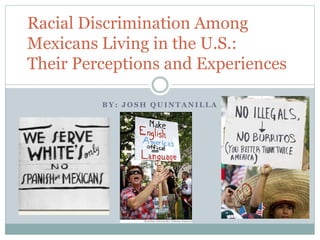
Racial Discrimination Among Mexicans in the U.S
- 1. B Y : J O S H Q U I N T A N I L L A Racial Discrimination Among Mexicans Living in the U.S.: Their Perceptions and Experiences
- 2. Overview The U.S. population will soar to 438 million by 2050 and the Hispanic population will triple (Pew Research Center). Hispanics will make up 29% of the U.S. population in 2050 (Pew Research Center). U.S. Census Bureau Report issued in June 2004 estimates that 6.5 percent of the U.S. population is defined as Mexican. It is important to investigate how Mexicans understand their treatment in society.
- 3. Overview This presentation will hypothesize the factors that lead to discrimination Nationality Language Ability Education Legal Status Skin Tone Martial Status Participants reported their experiences regarding discrimination Participants were given consent forms in order to conduct an ethical interview.
- 4. Methods Participants & Procedures Areas of Canton, Woodstock & Alpharetta Mexicans and Mexican Americans Snowball sampling 35 Face-to-Face Interviews About 8-10 min. per interview Telephone Interviews Interviews were conducted in Spanish & English
- 5. Gender Years Living in the U.S. 56% 44% Male Female 3% 9% 31% 34% 9% 11% 3% 0% 5% 10% 15% 20% 25% 30% 35% 40% General Demographics
- 6. Places of Discrimination School 16% Work 23% Gov't institutions 26% Restaurants /Stores 29% Other 6%
- 8. Nationality Nationality & Less Respect Once in while 61% 39% Native-born Foreign-born Native-born Foreign-born 41% 50% Findings: Nationality Chi-Square value .467 Not significant Gamma of -.08 Weak association
- 9. Nationality and Poorer Service in Restaurants and Stores, once in a while Significance & Association 0% 10% 20% 30% 40% 50% 60% 59% 36% Chi-Square Value .457 Not statistically significant Gamma .10 Moderate association Findings: Nationality & Poor Service
- 10. Language skills Language Skills and Employment/Promotion Denial 60% 40% Spanish Bilingual 0% 10% 20% 30% 40% 50% 60% 70% 80% Only Spanish Bilingual 77% 40% Findings: Language Skills Chi-Square value .037 Significant Lambda of .21 Moderate association
- 11. Education Level Education and Discrimination/Unfair Treatment by Individuals of Their Own Race 0% 5% 10% 15% 20% 25% 30% 27% 23% 26% 17% 3% 2% 32% 42% 26% High school graduates Some college College graduates Chi-Square value .567 Not significant Gamma of .12 Weak association Findings: Level of Education
- 12. Findings: Legal Status Undocumented 51% Student visa 3% Resident 20% Citizen 26%
- 13. Findings: Legal Status & Racial Slurs/Epithets Undocumented Mexicans are more likely than Mexican citizens and residents to have experienced racial insults and offensive names against them in the past 5 to 10 years 0% 10% 20% 30% 40% 50% 60% 70% 80% 77% 29% 38% Undocumented Resident Citizen Chi-Square value .046 Statistically significant Lambda of .20 Moderate association
- 14. Findings: Legal Status & Discrimination/Unfair treatment by individuals of their own race Undocumented 83% Residents 17% Undocumented Mexicans are more likely than Residents to experiences racial discrimination and unfair treatment by individuals of their own race Chi-square value .019 Significant Lambda of .23 Moderate association
- 15. Classification of Skin tones Very Dark Dark Medium Light Very Light
- 17. Skin tone and Physical Fights Mexicans with medium skin tones are more likely than those who are light skinned to have been in a physical fight in the past 5 to 10 years 36% 61% Light Medium Chi-square value of .037 Statistically significant With a lambda of .31 Evidence of a strong association
- 18. Martial Status Martial Status and Physical Fights 32% 59% 3% 3%3% Single Married Separated Divorced N/A 0% 20% 40% 60% 80% 100% 81% 28% Single Married Findings: Martial Status Chi-Square value .020 Statistically significant Lambda of 3.9 Evidence of strong association
- 19. Discussion As we can see, racial discrimination against Mexicans and Americans with Mexican descent (Chicanos) living in the U.S. still exists today. We have found that those individuals who are undocumented, single, medium skin toned, and those who do not have the ability to speak English are more inclined to be the victims of racial discrimination and unfair treatment in society.
- 20. Discussion: Why Does Discrimination Still Occur? Discrimination most often takes the form of ignorance. For those who have limited social worlds, one bad experience with a member of a particular group is easily generalized into a negative perception of everyone belonging to that group. Undocumented Immigrants tend to be discriminated against because they do not have equal rights as citizens do. People are sometimes subjected to different treatments because their primary/official language is associated with a particular group, class or category.
- 21. Discussion: Further Investigations Since the study only consisted of 35 participants, further research needs to be conducted to accomplish a more representative sample. Because of ethical reasons, minors were not included in this study. However, it is important that there be a specific study devoted to minors in the future. Finally, in order to fully understand racial discrimination among Latinos, additional groups of minorities need to be included for future studies.
- 22. Thank you for your time!